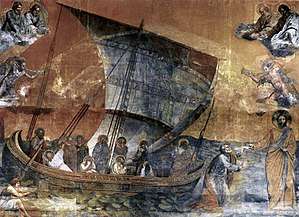Barque of St. Peter
The term Barque of St. Peter or Ship/Boat of St. Peter or Barque of the Church, symbolises the Roman Catholic Church as a barque. The symbolism refers to St. Peter, the first Pope, a fisherman who became one of the 12 Apostles of Jesus. The Roman Catholic Church believes the role of St. Peter and his Successors is steering the Barque of the Church.[1]

History
150-240 AD Tertullian "the founder of Western theology" referred to the Church as a ship in De Baptismo (On Baptism):
"...the apostles then served the turn of baptism whenin their little ship, were sprinkled and covered with the waves: that Peter himself also was immersed enough when he walked on the sea."[8] It is, however, as I think, one thing to be sprinkled or intercepted by the violence of the sea; another thing to be baptized in obedience to the discipline of religion. But that little ship did present a figure of the Church, in that she is disquieted "in the sea," that is, in the world,[9] "by the waves," that is, by persecutions and temptations; the Lord, through patience, sleeping as it were, until, roused in their last extremities by the prayers of the saints, He checks the world,[10] and restores tranquility to His own." [2]
c. 195 AD Clement of Alexandria approved the use of a ship as a symbol for signet rings in the third book of The Paedagogus:
"...let our seals be either a dove, or a fish, or a ship scudding before the wind, or a musical lyre, which Polycrates used, or a ship's anchor, which Seleucus got engraved as a device; and if there be one fishing, he will remember the apostle, and the children drawn out of the water." [3]
375 to 380 AD In the book II of the Apostolic Constitutions:
"When you call an assembly of the Church as one that is the commander of a great ship, appoint the assemblies to be made with all possible skill, charging the deacons as mariners to prepare places for the brethren as for passengers, with all due care and decency. And first, let the building be long, with its head to the east, with its vestries on both sides at the east end, and so it will be like a ship. In the middle let the bishop's throne be placed, and on each side of him let the presbytery sit down; and let the deacons stand near at hand, in close and small girt garments, for they are like the mariners and managers of the ship" [4]
1298 AD The Bark of St. Peter (mosaic), commonly known as the Navicella, by Giotto is commissioned for the Old Saint Peter's Basilica in Rome.
1596 AD In the Volume XII of the Annales Ecclesiastici historian Cardinal Baronius writes on the condition of the Irish Church in 566 AD:[5]
"...having made shipwreck in consequence of not following the Barque of St. Peter"
Featured on the Coat of Arms of the Archdiocese of Vancouver
References
- John Paul II (22 February 2001). "Eucharistic Celebration With the New Cardinals | Homily of John Paul II". The Holy See - Vatican.
- Tertullianus, Quintus. "XII". De Baptismo. p. 1214.
- Clement of Alexandria (c. 195). "Chapter 11. A Compendious View of the Christian Life". Paedagogus.
- Unknown (375–380). Apostolic Constitutions II.CS1 maint: date format (link)
- Baronius, Caesar (1596). Annales Ecclesiastici VII.